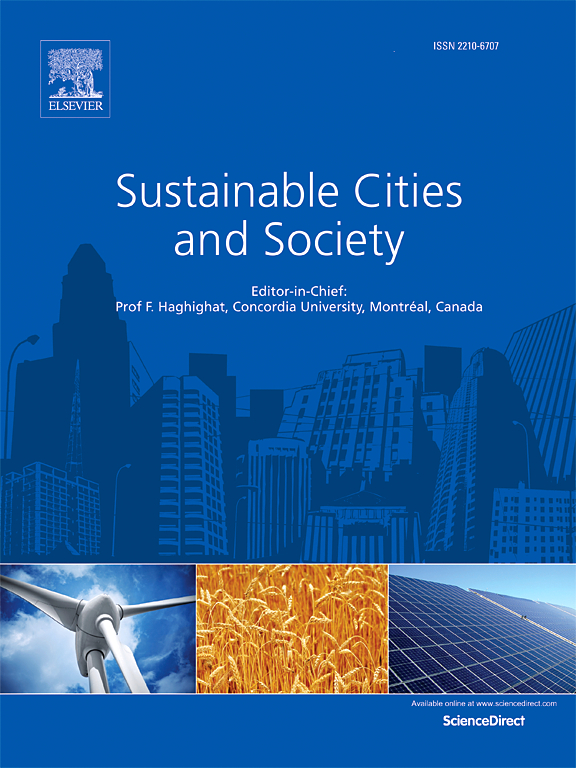日本稳定城市体系的尺度规律
IF 10.5
1区 工程技术
Q1 CONSTRUCTION & BUILDING TECHNOLOGY
引用次数: 0
摘要
尺度律量化了城市指标与人口规模之间的非线性关系。日本是典型的城市化水平较高的人口大国,但尺度法在日本的适用性尚未得到充分的探讨。在这里,我们通过分析1700多个城市的50多个城市指标来解决这一差距,这些指标包括教育、住房、经济、卫生和就业部门。结果显示,日本城市系统具有独特的稳定性,随着时间的推移(2005-2020年),尺度指数和残差的变化很小,这与快速城市化的系统不同。尽管大多数指标遵循预期的尺度制度,但由于独特的地方税收政策,财政收入的亚线性尺度关系偏离了理论预期。此外,规模调整后的指标显示出显著的空间集群,日本中部城市在就业方面表现突出,东北城市在纳税人收入方面表现突出。研究结果有助于理解高度城市化成熟系统的城市尺度规律。城市系统的稳定性保证了可预测性,突出了尺度法作为城市治理的理论指导,但也应与地方政策相结合。本文章由计算机程序翻译,如有差异,请以英文原文为准。
Scaling law in a stable urban system of Japan
Scaling law quantifies nonlinear relationships between urban indicators and population size. Japan typifies populous Asian countries with a high urbanization level, but the applicability of scaling law in Japan was underexplored. Here, we address this gap by analyzing over 50 urban indicators across more than 1700 municipalities, encompassing education, dwelling, economy, health, and employment sectors. Results revealed a distinctive stability in Japan's urban system, with minimal variations in scaling exponents and residuals over time (2005–2020), which is different from rapidly urbanizing systems. Despite most indicators following expected scaling regimes, the sub-linear scaling relationship for financial revenue deviated from the theoretical expectation due to unique local tax policies. Furthermore, scale-adjusted indicators reveal significant spatial clusters, with central Japan showing enhanced performance in employment and northeastern cities excelling in taxpayer income. Our findings contributed to understanding urban scaling law in highly urbanized mature systems. The stability of urban systems promises predictability, highlighting scaling law as a theoretical guide in urban governance, but should also be combined with local policies.
求助全文
通过发布文献求助,成功后即可免费获取论文全文。
去求助
来源期刊

Sustainable Cities and Society
Social Sciences-Geography, Planning and Development
CiteScore
22.00
自引率
13.70%
发文量
810
审稿时长
27 days
期刊介绍:
Sustainable Cities and Society (SCS) is an international journal that focuses on fundamental and applied research to promote environmentally sustainable and socially resilient cities. The journal welcomes cross-cutting, multi-disciplinary research in various areas, including:
1. Smart cities and resilient environments;
2. Alternative/clean energy sources, energy distribution, distributed energy generation, and energy demand reduction/management;
3. Monitoring and improving air quality in built environment and cities (e.g., healthy built environment and air quality management);
4. Energy efficient, low/zero carbon, and green buildings/communities;
5. Climate change mitigation and adaptation in urban environments;
6. Green infrastructure and BMPs;
7. Environmental Footprint accounting and management;
8. Urban agriculture and forestry;
9. ICT, smart grid and intelligent infrastructure;
10. Urban design/planning, regulations, legislation, certification, economics, and policy;
11. Social aspects, impacts and resiliency of cities;
12. Behavior monitoring, analysis and change within urban communities;
13. Health monitoring and improvement;
14. Nexus issues related to sustainable cities and societies;
15. Smart city governance;
16. Decision Support Systems for trade-off and uncertainty analysis for improved management of cities and society;
17. Big data, machine learning, and artificial intelligence applications and case studies;
18. Critical infrastructure protection, including security, privacy, forensics, and reliability issues of cyber-physical systems.
19. Water footprint reduction and urban water distribution, harvesting, treatment, reuse and management;
20. Waste reduction and recycling;
21. Wastewater collection, treatment and recycling;
22. Smart, clean and healthy transportation systems and infrastructure;
 求助内容:
求助内容: 应助结果提醒方式:
应助结果提醒方式:


